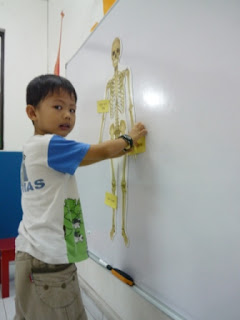Welcome to Eye-Day!
The Teachers (Aunties) at Clover had been planning for this day for three weeks, and we were all looking forward to amaze the children with what eyes can do and teach them how to protect their eyes.
We started off the day with Dr. Shanthi's presentation using a three-dimensional model of an eye. We were very honoured to have Dr. Shanthi, who is an eye-doctor and also our ex-student's parent. She had been very supportive and helpful in providing the information and Eye-Test materials prior to the Eye-Day.
The Teachers had prepared the children for 2.5 weeks beforehand by teaching them various parts of the eyes using the Montessori way. Hence, when Dr. Shanthi came to do the presentation, it was not that difficult for the children to understand what was going on.
Dr. Shanthi, with Umasivu (our ex-student) as assistant, showed our children the three-dimensional model of an eye. She was showing them how a lense looks like.
Dr. Shanthi put some pink sticky tapes on the top, bottom and the sides of a ping pong ball, and demonstrated how our eye muscles work to let our eye balls look up, down, side-ways and diagonally. So, now we all know each eye has 6 muscles to help us look around!
Dr. Shanthi's tips to protect our eyes:
1. Sit 6 metres (20 feet) away from the television when watching a program.
2. Children should only watch television program for a maximum of 1 hour a day.
3. The eyes must be ONE LONG RULER away from a book when reading and writing.
4. Do not rub the eyes.
Eye-Xercise
It was time to exercise our eyes. The children learned some eye-xercise from Auntie Shirin. This is to learn to relax our tired little eyes.
Step 1: Children closed their eyes tightly and opened them wide again. Repeat this several times.
Step 2: Stick out your index finger and make a big circle in front of you. As you do this, let your eyes follow your index fingers (don't move your head!).
Step 3: Stick out only 3 fingers from each hand and GENTLY roll them around your eyes.
Step 4: Rub your palms together to make them warm, then cover your eyes with your warm palms. Relax!
Eye Test
After the eye-xercise, our children were splitted into various groups. Some went for the eye-test first. They were seated 6 metres away from the number chart and were asked to call out the numbers selected for them. Most of them had pretty good eye-sight, phew!
Colour Blind Test
Another station in our "Clover Eye-Clinic" was the Colour-Blind-Test station. Children were tested on their distinction of colours by recognising numbers on the ishihara chart.
All Teachers were role-playing as Eye-Nurses by wearing some of the Teachers' husbands' over-sized white shirts. This put a smile on all the children's face as they started to call our school an Eye Hospital.
Optical Illusion
Drawings, pictures and diagrams can make fun of our eyes. We searched on the net for various pictures and did up a mini exhibition hall for Optical illusions. Each Teacher guided their own group of children to view the exhibitions at different times. The children were amazed and we as Teachers were amazed too by what the children could see from different perspectives. Yu Tong, who is only 3 years old, was very good at detecting hidden objects in the pictures. We were impressed!
Our 4-year-olds were looking at the exhibits under the guidance of "Nurse Margaret".
Our 5- and 6-year-olds were measuring the various sizes of the items seen on the pictures. Their eyes were playing trick on them! See below for examples of optical illusion arts that we showed our children.
Optical Illusion Art Example 1: Which middle circle is bigger?
(Answer: Both middle circles are of the same size!)
Optical Illusion Art 2: Do you see any animals in this picture? If yes, what are they and how many can you find?
(Answer: There are four horses in this picture.)
Eye-Show
The children watched an Eye-Show at our mini-theatre. The show made them realise the tests that we had done during the first part of the day (Eye-Test, Colour blind test). It was fun and a time when all the Teachers finally could catch their breath.
Eye-Craft
All the children did eye-crafts at the end of the Eye-Day. They were supposed to be optical illusion art. Some were successfully made, some not so, and we are going to try and make it again with the children for the coming weeks. This also made us realise that the experience of making the craft is very important to make the illusion work. Hence, we are going to make the children practice making them more before they can get it right.


























































